Passenger ship
A passenger ship is a merchant ship whose primary function is to carry passengers on the sea. The category does not include cargo vessels which have accommodations for limited numbers of passengers, such as the ubiquitous twelve-passenger freighters once common on the seas in which the transport of passengers is secondary to the carriage of freight. The type does however include many classes of ships designed to transport substantial numbers of passengers as well as freight. Indeed, until recently virtually all ocean liners were able to transport mail, package freight and express, and other cargo in addition to passenger luggage, and were equipped with cargo holds and derricks, kingposts, or other cargo-handling gear for that purpose. Only in more recent ocean liners and in virtually all cruise ships has this cargo capacity been eliminated.
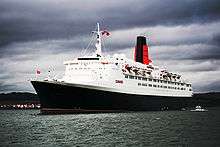
While typically passenger ships are part of the merchant marine, passenger ships have also been used as troopships and often are commissioned as naval ships when used as for that purpose.
Description

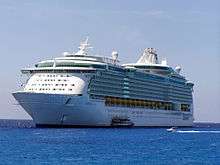
Passenger Ship Types: Passenger ships include ferries, which are vessels for day to day or overnight short-sea trips moving passengers and vehicles (whether road or rail); ocean liners, which typically are passenger or passenger-cargo vessels transporting passengers and often cargo on longer line voyages; and cruise ships, which often transport passengers on round-trips, in which the trip itself and the attractions of the ship and ports visited are the principal draw.
There are several main types:
Rough synopses of passenger ship types
- Cruise ships: For a long time, cruise ships were smaller than the old ocean liners had been, but in the 1980s, this changed when Knut Kloster, the director of Norwegian Caribbean Lines, bought one of the biggest surviving liners, the SS France, and transformed her into a huge cruise ship, which he renamed the SS Norway. Her success demonstrated that there was a market for large cruise ships. Successive classes of ever-larger ships were ordered, until the Cunard liner Queen Elizabeth was finally dethroned from her 56-year reign as the largest passenger ship ever built (a dethronement that led to numerous further dethronements from the same position).
- Ferries: They are vessels for day to day or overnight short-sea trips moving passengers and vehicles (whether road or rail).
- Ocean liners: An ocean liner is the traditional form of passenger ship. Once such liners operated on scheduled line voyages to all inhabited parts of the world. With the advent of airliners transporting passengers and specialized cargo vessels hauling freight, line voyages have almost died out. But with their decline came an increase in sea trips for pleasure and fun, and in the latter part of the 20th century ocean liners gave way to cruise ships as the predominant form of large passenger ship containing from hundreds to thousands of people, with the main area of activity changing from the North Atlantic Ocean to the Caribbean Sea.
Cruise ships vs. ocean liners
Although some ships have characteristics of both types, the design priorities of the two forms are different: ocean liners value speed and traditional luxury while cruise ships value amenities (swimming pools, theaters, ball rooms, casinos, sports facilities, etc.) rather than speed. These priorities produce different designs. In addition, ocean liners typically were built to cross the Atlantic Ocean between Europe and the United States or travel even further to South America or Asia while cruise ships typically serve shorter routes with more stops along coastlines or among various islands.
Both the RMS Queen Elizabeth 2 (QE2) (1969) and her successor as Cunard's flagship RMS Queen Mary 2 (QM2), which entered service in 2004, are of hybrid construction. Like transatlantic ocean liners, they are fast ships and strongly built to withstand the rigors of the North Atlantic in line voyage service,[1] but both ships are also designed to operate as cruise ships, with the amenities expected in that trade. QM2 was superseded by the Freedom of the Seas of the Royal Caribbean line as the largest passenger ship ever built; however, QM2 still hold the record for the largest ocean liner. The Freedom of the Seas was superseded by the Oasis of the Seas in October 2009.[2]
Measures of size

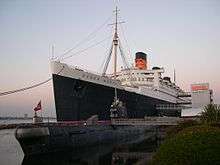
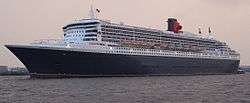
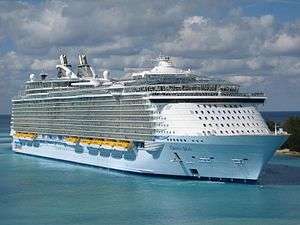
Because of changes in historic measurement systems, it is impossible to make meaningful and accurate comparisons of ship sizes over time beyond length. Three alternative forms of measurement are ship volume, weight, and weight of water it displaces. A fourth, deadweight tonnage (DWT), is a measure of how much mass a ship can safely carry, and is thus more relevant to measuring cargo vessels than passenger ships.
Historically, gross register tonnage (GRT) was a measure of the internal volume of certain enclosed areas of a ship divided into "tons" equivalent to 100 cubic feet of space (about 2.83 m3). The displacement (or displacement tonnage) is a measure of both a ship's weight and the weight of water (measured by volume and converted into tons) it displaces, which are one and the same by Archimedes' principle. While seemingly straightforward, it has four variants in measure, Loaded displacement, Light displacement, Normal displacement, and Standard displacement. Of these, the first is most appropriate to measuring a passenger vessel.
Gross tonnage (GT) is a comparatively new measure, only adopted in 1982 to replace GRT. It is calculated based on "the moulded volume of all enclosed spaces of the ship", and is used to determine things such as a ship's manning regulations, safety rules, registration fees, and port dues. It is produced by a mathematical formula, and does not distinguish between mechanical and passenger spaces, and thus is not directly comparable to historic GRT measurements.
While a high displacement can indicate better sea keeping abilities,[3] gross tonnage is nowadays promoted as the most important measure of size for passenger vessels, as the ratio of gross tonnage per passenger – the Passenger/Space Ratio – gives a sense of the spaciousness of a ship, an important consideration in cruise liners where the onboard amenities are of high importance.[4][5]
Historically, a ship's GRT and displacement were somewhat similar in number. For example, RMS Titanic, put in service in 1912, had a GRT of 46,328 and a displacement reported at over 52,000 tons.[6] Similarly, Cunard Line's mid-1930s RMS Queen Mary and RMS Queen Elizabeth were of approximately 81,000 – 83,000 GRT and had displacements of over 80,000 tons.[7]
Today, due to changes in construction, engineering, function, architecture, and, crucially, measurement system – which measures functionally all of a ship's internal volume, not just part of it – modern passenger ships' GT values are much higher than their displacements. The Cunard Queens' current successor, the 148,528 GT RMS Queen Mary 2,[8][9] has been estimated to only displace approximately 76,000 tons.[10][11] With the completion in 2009 of the first of the over 225,000 GT Oasis Class dedicated cruise ships, Oasis of the Seas, passenger ships' displacements have finally risen to 100,000 tons,[12] well less than half their GT.
This new class is characteristic of an explosive growth in gross tonnage, which has more than doubled from the largest cruise ships of the late 1990s. This reflects the much lower relative weight of enclosed space in the comparatively light superstructure of a ship versus its heavily reinforced and machinery-laden hull space, as cruise ships have grown slab-sided vertically from their maximum beam to accommodate more passengers within a given hull size.
Primary maritime cargo types
| Primary maritime cargo types | ||||
|---|---|---|---|---|
| Cargo type | Countable | Packaging | Container | Remarks |
| Break bulk cargo or general cargo | Countable | Yes | No | Break bulk cargo or general cargo are goods that must be loaded individually, and not in intermodal containers nor in bulk as with oil or grain. Ships that carry this sort of cargo are called general cargo ships. The term break bulk derives from the phrase breaking bulk—the extraction of a portion of the cargo of a ship or the beginning of the unloading process from the ship's holds. These goods may not be in shipping containers. Break bulk cargo is transported in bags, boxes, crates, drums, or barrels. Unit loads of items secured to a pallet or skid are also used.[13] |
| Bulk cargo (bulk dry cargo) | Weighable | No | No | Bulk cargo is commodity cargo that is transported unpackaged in large quantities. It refers to material in either liquid or granular, particulate form, as a mass of relatively small solids, such as petroleum/crude oil, grain, coal, or gravel. This cargo is usually dropped or poured, with a spout or shovel bucket, into a bulk carrier ship's hold, railroad car/railway wagon, or tanker truck/trailer/semi-trailer body. Smaller quantities (still considered "bulk") can be boxed (or drummed) and palletised. Bulk cargo is classified as liquid or dry. |
| Bulk liquid cargo | Weighable | No | No | A tanker (or tank ship or tankship) is a ship designed to transport or store liquids or gases in bulk. Major types of tankship include the oil tanker, the chemical tanker, and gas carrier. Tankers also carry commodities such as vegetable oils, molasses and wine. In the United States Navy and Military Sealift Command, a tanker used to refuel other ships is called an oiler (or replenishment oiler if it can also supply dry stores) but many other navies use the terms tanker and replenishment tanker. A wide range of products are carried by tankers, including:
|
| Container cargo | Countable | Yes | Yes | Containerization is a system of intermodal freight transport using intermodal containers (also called shipping containers and ISO containers).[14] The containers have standardized dimensions. They can be loaded and unloaded, stacked, transported efficiently over long distances, and transferred from one mode of transport to another—container ships, rail transport flatcars, and semi-trailer trucks—without being opened. The handling system is completely mechanized so that all handling is done with cranes [15] and special forklift trucks. All containers are numbered and tracked using computerized systems. |
| Neo-bulk cargo | Weighable | Yes | No | In the ocean shipping trade, neo-bulk cargo is a type of cargo that is a subcategory of general cargo, alongside the other subcategories of break-bulk cargo and containerized cargo.[16] (Gerhardt Muller, erstwhile professor at the United States Merchant Marine Academy and Manager of Regional Intermodal Planning of the Port Authority of New York and New Jersey, promotes it from a subcategory to being a third major category of cargo in its own right, alongside general and bulk cargo.[17][18]) It comprises goods that are prepackaged, counted as they are loaded and unloaded (as opposed to bulk cargo where individual items are not counted), not stored in containers, and transferred as units at port.[16] Types of neo-bulk cargo goods include heavy machinery, lumber, bundled steel, scrap iron, bananas, waste paper, and cars.[16][19][18] The category has only become recognized as a distinct cargo category in its own right in recent decades.[17][18] |
| Passenger cargo | Countable | No | No | A passenger ship is a merchant ship whose primary function is to carry passengers on the sea. |
| Project cargo | Weighable | Yes | No | Project cargo is a term used to broadly describe the national or international transportation of large, heavy, high value, or critical (to the project they are intended for) pieces of equipment. Also commonly referred to as heavy lift, this includes shipments made of various components which need disassembly for shipment and reassembly after delivery.[20] |
| Refrigerated cargo | Weighable | Yes | Yes / no | A reefer ship is a refrigerated cargo ship, typically used to transport perishable commodities which require temperature-controlled transportation, such as fruit, meat, fish, vegetables, dairy products and other foods. |
| Roll-on/roll-off cargo | Countable | No | No | Roll-on/roll-off (RORO or ro-ro) ships are vessels designed to carry wheeled cargo, such as cars, trucks, semi-trailer trucks, trailers, and railroad cars, that are driven on and off the ship on their own wheels or using a platform vehicle, such as a self-propelled modular transporter. This is in contrast to lift-on/lift-off (LOLO) vessels, which use a crane to load and unload cargo. |
Safety regulations
Passenger ships are subject to two major International Maritime Organization requirements : to perform musters of the passengers (...) within 24 hours after their embarkation and to be able to perform full abandonment within a period of 30 minutes from the time the abandon-ship signal is given.[21]
Transportation Research Board research from 2019 reported passenger vessels, much more than freight vessels, are subject to degradations in stability as a result of increases in lightship weight. Passenger vessels appear to be more pressing candidates for lightship weight-tracking programs than freight vessels.[22]
Design considerations
Passengers on ships without backup generators suffer substantial distress due to lack of water, refrigeration, and sewage systems in the event of loss of the main engines or generators due to fire or other emergency. Power is also unavailable to the crew of the ship to operate electrically powered mechanisms. Lack of an adequate backup system to propel the ship can, in rough seas, render it dead in the water and result in loss of the ship.[23] The 2006 Revised Passenger Ship Safety Standards address these issues, and others, requiring that ships ordered after July, 2010 conform to safe return to port regulations; however, as of 2013 many ships remain in service which lack this capacity.[24]
After October 1, 2010, the International Convention for the Safety of Life at Sea (SOLAS) requires passenger ships operating in international waters must either be constructed or upgraded to exclude combustible materials. It is believed some owners and operators of ships built before 1980, which are required to upgrade or retire their vessels, will be unable to conform to the regulations.[24] Fred Olsen's Black Prince, built in 1966 was one such ship, but was reported to be headed for inter-island service in Venezuelan waters.[25]
External safety measures
The International Ice Patrol was formed in 1914 after the sinking of the RMS Titanic to address the long-outstanding issue of iceberg collision.
Notes
- "Winter 03-04: A Ship for the Sea". Cruise Industry News. Retrieved 2012-05-23.
- "Royal Caribbean orders .24B cruise ship - Boston.com". Archived from the original on 20 February 2009.
- "Internet Archive Wayback Machine" (PDF). Retrieved 2012-05-23.
- "Glossary, definition of Passenger Space Ratio". Information and Explanations. choosecruising.com. Archived from the original on 2010-08-29. Retrieved 2007-12-28.
- "Cruise Ship Tonnage". 123Ttravel.com. Archived from the original on October 11, 2007. Retrieved 2007-12-28.
- Titanic's DimensionsTitanic's Dimensions Archived May 27, 2006, at the Wayback Machine
- "Queen Mary Home". Atlanticliners.com. Retrieved 2012-05-23.
- United States Coast Guard Maritime Information Exchange, Queen Mary 2 Archived 2013-05-23 at the Wayback Machine, Retrieved 2012-03-26
- "Queen Mary 2 (9241061)". LR Class Direct. Lloyd's Register. Retrieved 2012-07-19.
- "Archived copy". Archived from the original on 2006-06-28. Retrieved 2006-06-21.CS1 maint: archived copy as title (link)
- "Archived copy". Archived from the original on 2006-05-29. Retrieved 2006-06-04.CS1 maint: archived copy as title (link)
- If Royal Caribbean builds it, 6,400 could comeBoston Globe (February 7, 2006).
- Notes on Cargo Work by J. F. Kemp and Peter Young, 1971 (3rd edition); page 31. ISBN 0-85309-040-8.
- Edmonds, John (2017-03-03). "The Freight Essentials: Getting Your Products Across The Ocean". Retrieved 2017-09-01.
- Lewandowski, Krzysztof (2016). "Growth in the Size of Unit Loads and Shipping Containers from Antique to WWI". Packaging Technology and Science. 29 (8–9): 451–478. doi:10.1002/pts.2231. ISSN 1099-1522.
- CambridgeSystematics 1998, pp. 79.
- Muller 1998, pp. 90.
- Muller 1995, pp. 3.
- Seyoum 2008, pp. 207.
- "About Project Cargo Network". Project Cargo Network. Archived from the original on 1 February 2013. Retrieved 6 December 2012.
- "A ship is its 'own best lifeboat'". Lloyd's List Australia. 18 January 2012. Archived from the original on 21 May 2013. Retrieved 20 January 2012.
- National Academies of Sciences, Engineering (2020-01-09). Review and Update of U.S. Coast Guard Vessel Stability Regulations and Guidance.
- Barry Meier; John Schwartz (February 24, 2013). "Lack of Backup Power Puts Cruise Passengers at the Ocean's Mercy". The New York Times. Retrieved February 25, 2013.
- "Hidden Depths of SOLAS" WorldCruise-Network.com 8 September 2010, accessed February 25, 2013
- Reinikainen, Kari (2009-05-06). "Fred. Olsen sells Black Prince for further trading". Cruise Business Online. Cruise Media Oy Ltd. Archived from the original on 2009-10-11. Retrieved 2009-05-10.
References
- Durand, Jean-François. Autour du Monde Paquebots: Cruise Ships Around the World. Editions marines, 1996. [bilingual text]
- Marin, Pierre-Henri. Les paquebots, ambassadeurs des mers, collection " Découvertes Gallimard " (nº 75), série Techniques. Paris: Gallimard, 1990.